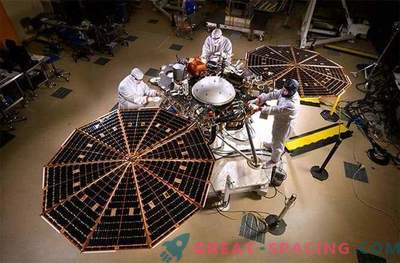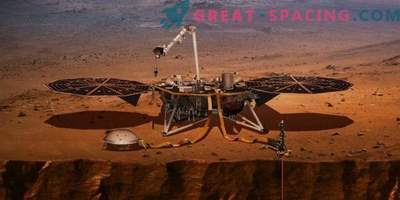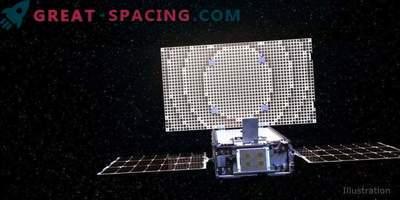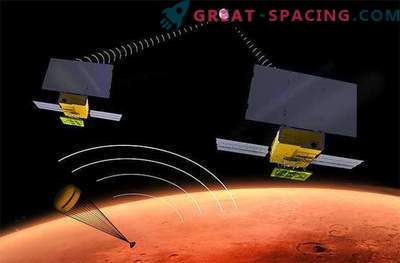
NASA's illustration (March 2018) shows MarCO twin spaceships flying over Mars from Earth against the backdrop of a distant Sun. They will be the first representatives of the technology of small satellites CubeSat, who will visit deep space
A pair of small experimental satellites accompanying the NASA InSight spacecraft are preparing to meet the biggest challenge. Their mission is to transmit information about the passage of the apparatus through the atmosphere of Mars and landing on the surface. The satellites were named WALL-E and EVE in honor of the main characters of the 2008 cartoon. They will pass within a few thousand miles of Mars when the ship tries to make a risky landing.
If the satellites transmit radio signals from InSight to ground controllers at a distance of about 160 million km, then within a few minutes scientists will learn how the landing went. In the meantime, let's look at some facts about the satellites that have demonstrated themselves during the flight.
Hitchhikers
WALL-E and EVE (in size resemble a portfolio) rolled on the same rocket that launched the InSight mission to Mars in May. CubeSat always become an additional burden to the main mission, because it is too small and inexpensive. The MarCO project, created and managed by NASA's Jet Propulsion Laboratory, will cost $ 18.5 million. Flight Features
NASA controllers held satellites at a distance of 10,000 km from InSight during a 483 million km trip to Mars to prevent any possibility of collisions or overlapping signals. Because of this, they also decided to divide among themselves.
Who was a good boy?
It is worth noting that EVE behaved better than WALL-E during the flight to the Red Planet. Each satellite has the same type of cold gas engine that is used in fire extinguishers to spray foam. It turned out that WALL-E was faced with a technical problem that could be fixed immediately after the ascent.

In a NASA photo from March 2018, engineer Joel Steinkraus uses light to test solar cells on one of the MarCO space satellites at the Jet Propulsion Laboratory (Pasadena, California)
Trial Run
In June, WALL-E and EVE conducted a series of radio-relay tests using signals from a large antenna near Palo Alto (California). The test added to scientists that CubeSat can handle the signaling from InSight on the day of landing. Last month, a pair of satellites sent a photo of Mars from a distance of 13 million km.
Waiting period
We'll have to wait 8 minutes and 7 seconds to receive a radio signal from Mars to Earth (one way). It will take less than a minute to receive a signal from InSight with the assistance of mini-satellites. That is, NASA will be able to learn about the fate of the landing vehicle almost in real time. Future goal
NASA seeks to explore new worlds, so it will be extremely convenient to organize posts on the planets for further launches and landings. A spacecraft in Mars orbit serves as a liaison when the agency sends a landing module. If small satellites prove functionality in deep space, they can be sent to asteroids and dwarf planets. Moreover, this technology will provide more speed in the creation and will save.
After Mars
We do not know for sure whether the satellites will cope with the task. However, they will approach Mars and remain in an elliptical orbit around the sun. Engineers expect that WALL-E and EVE will continue to work for a couple of weeks until the fuel runs out.











































